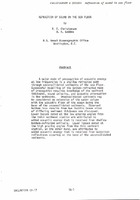| dc.contributor.author | Christensen, R. E. | |
| dc.contributor.author | Geddes, W. H. | |
| dc.date.accessioned | 2018-10-11T14:10:10Z | |
| dc.date.available | 2018-10-11T14:10:10Z | |
| dc.date.issued | 1975/10 | |
| dc.identifier | 312 | |
| dc.identifier.govdoc | CP-17/4 | |
| dc.identifier.uri | http://hdl.handle.net/20.500.12489/726 | |
| dc.description.abstract | A major mode of propagation of acoustic energy at low frequencies is a shallow refracted path through unconsolidated sediments of the sea floor. Successful modelling of the bottom-refracted mode of propagation requires knowledge of the sediment thickness, sound velocity, and acoustic attenuation in the sediments. Unconsolidated sediments may be considered an extension of the water column with the acoustic floor of the ocean being the base of the unconsolidated sediments. Observed bottom loss results from two Pacific Ocean sites of differing sediment thickness are discussed. Lower losses noted at the low grazing angles from the thick sediment station are attributed to added acoustic energy that is received from shallow bottom-refracted ~rrivals. Lower losses noted at ·the high grazing angles from the thin sediment station, on the other hand, are attributed to added acoustic energy that is received from subbottom reflections occuring at the base of the unconsolidated sediments. | |
| dc.format | 17 p. : ill. ; digital, PDF file | |
| dc.language | English | |
| dc.publisher | NATO. SACLANTCEN | |
| dc.source | In: Ocean Acoustic Modelling (SACLANTCEN Conference Proceedings CP-17), Part 4, 1975, pp. 16-1 - 16-17. | |
| dc.subject | Seafloor | |
| dc.subject | Seafloor sediments | |
| dc.subject | Acoustic refraction | |
| dc.subject | Low frequency acoustics | |
| dc.subject | Sound attenuation | |
| dc.subject | Acoustic reflection | |
| dc.title | Refraction of sound in the sea floor | |
| dc.type | Papers and Articles | |
| dc.type | Conference Proceedings (CP) | |
